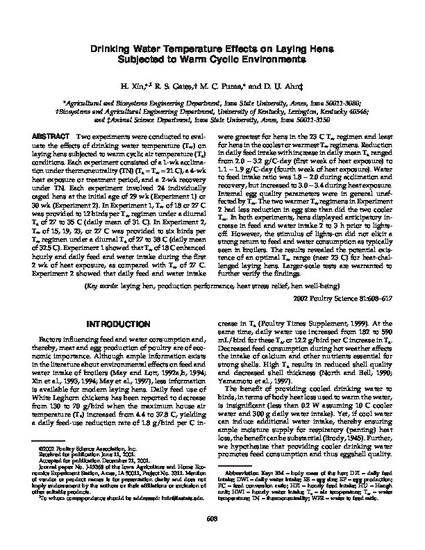
Two experiments were conducted to evaluate the effects of drinking water temperature (Tw) on laying hens subjected to warm cyclic air temperature (Ta) conditions. Each experiment consisted of a 1-wk acclimation under thermoneutrality (TN) (Ta = Tw = 21 C), a 4-wk heat exposure or treatment period, and a 2-wk recovery under TN. Each experiment involved 24 individually caged hens at the initial age of 29 wk (Experiment 1) or 30 wk (Experiment 2). In Experiment 1, Tw of 18 or 27 C was provided to 12 birds per Tw regimen under a diurnal Ta of 27 to 35 C (daily mean of 31 C). In Experiment 2, Tw of 15, 19, 23, or 27 C was provided to six birds per Tw regimen under a diurnal Ta of 27 to 38 C (daily mean of 32.5 C). Experiment 1 showed that Tw of 18 C enhanced hourly and daily feed and water intake during the first 2 wk of heat exposure, as compared with Tw of 27 C. Experiment 2 showed that daily feed and water intake were greatest for hens in the 23 C Tw regimen and least for hens in the coolest or warmest Tw regimens. Reduction in daily feed intake with increase in daily mean Ta ranged from 2.0 to approximately 3.2 g/C-day (first week of heat exposure) to 1.1 to approximately 1.9 g/C-day (fourth week of heat exposure). Water to feed intake ratio was 1.8 to approximately 2.0 during acclimation and recovery, but increased to 3.0 to approximately 3.4 during heat exposure. Internal egg quality parameters were in general unaffected by Tw. The two warmer Tw regimens in Experiment 2 had less reduction in egg size than did the two cooler Tw. In both experiments, hens displayed anticipatory increase in feed and water intake 2 to 3 h prior to lights-off. However, the stimulus of lights-on did not elicit a strong return to feed and water consumption as typically seen in broilers. The results revealed the potential existence of an optimal Tw range (near 23 C) for heat-challenged laying hens. Larger-scale tests are warranted to further verify the findings.
Available at: http://works.bepress.com/richard-gates/81/

This article is published as Xin, H., R. S. Gates, M. C. Puma, and D. U. Ahn. "Drinking water temperature effects on laying hens subjected to warm cyclic environments." Poultry Science 81, no. 5 (2002): 608-617. doi: 10.1093/ps/81.5.608.